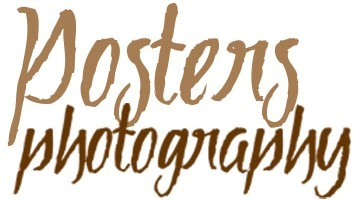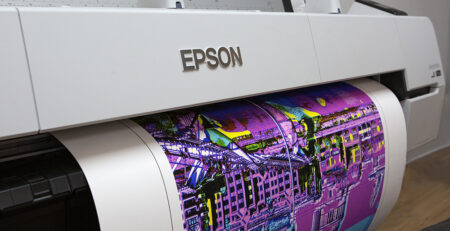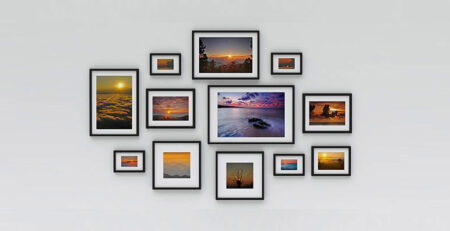Know Your Giclee Print
What is Giclee
Giclee printing (pronounced zhee-clay) is a method of printing to create high quality Images. Originating from the French term, “la giclée,” it means, “that which is sprayed or squirted.” Giclee printing began in the 1980s, when high-resolution digital scans were used in conjunction with archival quality inks. In 1991, printmaker Jack Duganne coined the term for fine digital prints that are made on inkjet printers.
Giclee printing is a type of inkjet printing, but not all inkjet prints are giclee prints. The intention of giclee printing is to produce a product at a higher quality and with a longer lifespan than a standard desktop inkjet printer that one uses at home or office.
Giclee prints are made with several materials and technologies. What makes a giclee print superior is the combination of high resolution, a layered paper to absorb different colours of pigment sprays, high quality pigment-based inks and a high-end wide format inkjet printer. that can hold 12 colour ink cartridges
The choice of paper is crucial: the paper or substrate used to print the final piece must be of archival quality, acid free and 100% cotton or rag base These types of papers are the best for longevity and true colour reproduction,
The biggest difference between a standard inkjet print and a giclee print is that Giclees are printed using pigment-based inks rather than dye-based inks that are found in office or home inkjets. Pigment-based inks have a longer lifespan: they can last anywhere from 100 – 200 years without significant fading. The type of printer used for giclee printing is usually a larger format model that specifically uses pigment-based inks and can hold 12 colour ink cartridges. Generally, the print with such printers have a higher the colour range, with all in between colours, as well as deeper blacks.
Giclee prints besides being a true 100% reproduction of the original art, are also resistant to smudging, sun or humidity damage.
The Advantages of Giclee Prints
- Colour :
The Giclee Printers use 12 colours of Pigment inks as against 4-6 heads of home office inkjet printers. This means that the array or spectrum of colours is far wider and fluid, the colours being more intense than that of inkjet printer.
- Resolution:
The inkjet printer may have a very high resolution of 1200 but a Giclee is much higher at 4800 which is for time that of an inkjet printer. Besides this the Giclee printer has a much finer spray, spraying millions of microscopic particles of Ink onto the layered paper/camvas, whereby the dot or pixel is much smaller resulting in a much finer finish, the dots blending together to form sharp and smooth and intense image with a full array of different intermediate hues and tines as compared to home or office inkjet printers.
- The Print Media:
Unlike Inkjet printers which can print on digital photo papers the Giclee can handle thicker papers with texture and canvas. Inkjets Archival papers are often rag based thicker papers with textures. The Giclee printer with its finer spray produces high definition images on these textured papers and canvas
- Longevity:
Giclee Printers use pigment inks which do not fade or change colour for hundreds of years, unlike inkket printers who use dye inks which change colour after a few years. Pirints on Archival paper/canvas therefor last a 100 years/
The Posters Photography Giclee:
The Posters Photography giclee print is therefore far superior both in resolution and colour, as the artwork is high resolution at 300dpi and processed by expert photographic technicians in ai guided photoshop with smooth pixels and would be sharp and not pixellated as well in colour spectrum, covering all in between hues and tones and shades of colours which makes it a true reproduction of what a human eye would normally see in real life, as against a print made by downloading an image from the net and printing it on a home printer or at a nearby photo shop or xerox outlet, where the resultant print will not only not have the fine detail being a 72 dpi resolution image, but also miss out all the different intermediate hues and the print may look pixelated and blotchy, with missing or different hues and tones, and in a few months the print fading or turning a undesirable yellow from sunlight and room humidity exposure
Difference Giclee Print and Digital Print:
Giclee Prints atPosters Photography |
Inkjet Prints by Shops and Photo Studio
|
||
| 1 | 12 Colour Giclee Printer assuring full spectrum of colour with 98% accuracy | 1 | 4-6 Colour Inkjet Printer which means colours could be about 10-15% different than the original |
| 2 | Professionally mastered sRGB Photoshop files with either Camera or high end Scanner with 300 DPI Resolution | 2 | Internet downloads or mobile camera files at 72 DPI |
| 3 | Prints on archival acid free cotton rag based paper or canvas | 3 | Prints on commercial Digital Photo Paper |
| 4 | Pigment based archival inks, which wont fade over a period of 100-200 Years. | 4 | Dye based inks which may fade or change colour over a period of a few years |
| 5 | Expected life : over 100 years without fading | 5 | Expected life : less than 10 years |
How long will giclee prints last?
If properly cared for by the owner, a giclee print will last at least 100 years without significant fading. If your giclee print is framed and hung in a location outside of direct sunlight, it can last even longer.






Comments (2)
Portraits
This topic is simply incomparable :), I’m interested)))